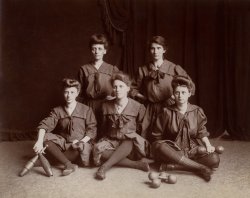
MAY CONTAIN NUTS

Search Shorpy
SHORPY ART

Framed or unframed, desk size to sofa size, printed by us in Arizona and Alabama since 2007. Explore now.
Join and Share
Ad-Free Shorpy
Shorpy is funded by you. Patreon contributors get an ad-free experience.
Learn more.

Recent comments
- Freeze Frame
- Texas Flyer wanted
- Just a Year Too Soon
- WWII -- Replacing men with women at the railroad crossing.
- Yes, Icing
- You kids drive me nuts!
- NOT An Easy Job
- I wonder
- Just add window boxes
- Icing Platform?
- Indiana Harbor Belt abides
- Freezing haze
- Corrections (for those who care)
- C&NW at Nelson
- Fallen Flags
- A dangerous job made worse
- Water Stop
- Passenger trains have right of way over freights?
- Coal
- Never ceases to amaze me.
- Still chuggin' (in model form)
- Great shot
- Westerly Breeze
- For the men, a trapeze
- Tickled
- Sense of loneliness ...
- 2 cents
- Charm City
- What an Outrage
- Brighton Park
Member Photos
The Shorpy
Print Emporium
Print Emporium
Search Shorpy
Search results -- 30 results per page
- Grand Rapids Chair: 1908
- Circa 1908. "Grand Rapids Chair Co., Grand Rapids, Michigan." 8x10 inch dry plate glass negative, Detroit Publishing ... Posted by Dave - 08/21/2012 - 5:19pm -
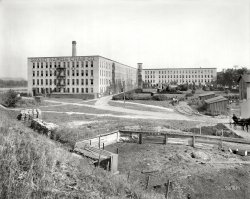
- Grand Rapids: 1908
- Grand Rapids, Michigan, circa 1908. "Canal Street from corner of Monroe." Merchants ... is Sweet's Hotel, on the site of the Pantlind (now Amway Grand Plaza) Hotel built in 1913.
(The Gallery, DPC, Stores & Markets) ... Posted by Dave - 05/17/2014 - 11:34pm -
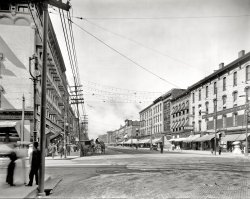
- Coming and Going: 1908
- ... forward to learning more about old steam locomotives!
Grand Rapids and Indiana Railroad These engines seen here are of the 4-4-0 wheel ... Posted by Dave - 08/09/2012 - 1:18pm -
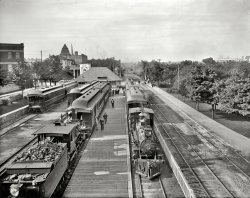
- Didn't I Have Six Dice?
- "A Winning Miss" in 1911. Art Photo Co., Grand Rapids, Mich. View full size.
Wow, check out the size of her… ... Posted by Dave - 11/29/2007 - 5:54pm -
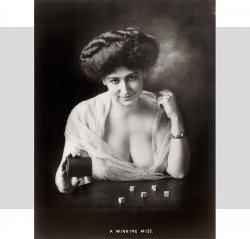
- Vagabonds: 1937
- ... and grill – all made by the Hayes Body Corporation in Grand Rapids, Michigan. The engines at first were a 65 hp design by Elbert J. Hall, ... Posted by Dave - 07/12/2014 - 2:18pm -
![Vagabonds: 1937 Washington, D.C. June 4, 1937. "Trailer camp." Harris & Ewing takes us into the late 1930s with a "new" batch of 1,945 glass negatives. View full size.
Parade flagCurious flag mounted on the fender, could it have been required when pulling a trailer?
The Good Old DaysWhen a stubborn car could be cured with the tools you could cram into your back pocket and there were no electronic gizmos involved. Looks like a Dodge.
I was born in 1937and look forward to more pictures of my parents' world at the time.
Too many moving partsWhat my father and his friends always said about the latest newfangled washing machines. Is the father in this picture secretly wishing for the simplicity of his old Model T, with no water pump, distributor, generator, battery, starter, gas gauge or roll-up windows to worry about? Or is he glad these conveniences have been brought to a reliable state of mass production as he teaches his son the finer points of adjustment?
Cool ShortsNot often Shorpy shows clothing that fits today's style.
The kid's shorts would fit perfectly today. Correct length and all. But not his shoes. Not by a longshot.
Don't Look Like VagabondsAn orchard in the background suggests a labor camp but the travel trailer and the car suggest a vacation of sorts, maybe a "working" vacation.
The trailer looks almost new, no dents, broken glass, windows open, roof vent operational ana d the car looks to be in good shape, too. The bottom of the spare tire shows road dirt but this doesn't strike me as a "Grapes of Wrath" type migration. hey, is that a radio antenna sticking out of the top of the trailer?
["Vagabond," in addition to meaning wanderer, was a brand of travel trailer as well as the name of countless motels. - Dave]
Plugged InThere seems to be an electric light with a shade and an empty light cord comming down from somewhere out of sight from the top of the picture.
Grapes, UpgradedSeems straight out of "The Grapes of Wrath," though these folks seems a little better off.
Trailer CampThe trailer looks like it's plugged into electric and there's an electric light hanging overhead - Grapes of Wrath this is not.
Curious Flag... That's a fender marker. So you could see where the edge of your fender was while parking and not bash it all up. The other side should have one, too.
1931 De VauxThe car is a 1931 De Vaux 6-75 sedan, made by the De Vaux-Hall Motors Corporation. It was the brainchild of Norman de Vaux, who had on-again off-again ties with General Motors and built the Chevrolet and non-GM Durant factories in Oakland, California. Starting at $595, the De Vaux was an inexpensive assembled car – that is, it was put together with parts from different manufacturers. The car bodies were leftover 1930 Durants with different fenders, hood and grill – all made by the Hayes Body Corporation in Grand Rapids, Michigan. The engines at first were a 65 hp design by Elbert J. Hall, who had co-designed the Liberty engine of WWI fame and co-founded the Hall-Scott Motor Car Company in Berkeley, California. That is the engine in the picture and it was capable of moving the car along at 70 - 80 miles per hour. Later Continental supplied four and six cylinder engines, as they did for Durant, Peerless, Jordan and many other makes.
De Vaux-Hall Motors acquired the Durant factory in Oakland as well as a factory in Grand Rapids leased from the Hayes Body Corporation, and began building De Vaux automobiles in both places. Unable to keep up with sudden demand, De Vaux-Hall only produced 4,808 vehicles in 13 months before they sold to Continental Motors Corporation in 1932. Continental reportedly produced another 4,200 cars called the Continental De Vaux before discontinuing production in 1934. Norman de Vaux repurchased the assets in hopes of restarting production, but in 1936 finally sold the Oakland factory to GM.
There are some 23 Oakland built and around 32 Grand Rapids built De Vaux automobiles still surviving today.
As far as the travel trailer goes, it is the ubiquitous “bread loaf” shape made by numerous manufacturers in the 1930’s including Roycraft, Schult, Kozy Coach, Glider, etc. There were over 2000 trailer manufacturers in 1937. Pierce Arrow made a few hundred of them in the late thirties, and even the Hayes Body Corporation manufactured a similar style. Plus there were dozens of do-it-yourself plans available for the handyman. My best guess is that this is most likely a mid-thirties Silver Dome Hyway model.
ContrastInteresting modern electrical connections to the trailer contrasted with the befringed pull-down shade on the driver-side car window.
Caravan park all rightThe crud on the spare was most likely thrown up from the front wheel. The name "HALL"appears to be embossed on the engine block. Would that indicate what make of car it is?
What's the make ...of the car? The engine block has the word "HALL" cast into the side.
110V of Fine Livin'It looks like the light is plugged/spliced into the top of the trailer.
The trailerWhat kind of material is the trailer made of, I wonder?
Old travel trailersWhat would the external walls of the travel trailer in this photo be made of? It looks sort of like fiberglass although I figure it would be much too early for that. It does have a pattern on it.
[Painted aluminum would be my guess. - Dave]
Fairly well offThis family seems to have fared quite well through the Depression. They look well dressed and the man sports "romeros," slip-on shoes popular until the 1950's. The car and trailer both look well maintained. It appears another member of the family or a neighbor friend is coming around the front of the trailer. For most of 1941, our family of four lived in a 19-foot trailer similar to this, with two doors on the curb-side.
Hall-ScottTwo talented young Californians, Elbert J. Hall and Bert C. Scott, founded the legendary Hall-Scott engine company by producing gasoline powered rail cars. The duo then went on to build motor cars from 1910 to 1921 before moving on to aircraft and marine engines, where the enjoyed their greatest success.
In WWI they produced a family of engines for the “Liberty Motor” program. The engines shared the same cylinder dimensions in 4, 6, 8 and 12 cylinders, with interchangeable parts, designed to be mass produced. No matter the size engine, these low RPM engines were reliable and light weight, producing a very favorable power to weight ratio. Hall-Scott engines were among the best known in aviation history.
After WWI, Hall-Scott left their leadership role in the aviation market to turn to producing engines for trucks, buses, boats and power units.
American Car and Foundry bought Hall-Scott in 1925. ACF used Hall-Scott's fame to advertise their buses as being Hall-Scott powered. They refused to sell engines to others. ACF made an exception for International trucks. The Internationals sported Hall-Scott engines in the 1920s and early 1930s. The engines ran vertically or horizontally, on LPG or gasoline.
deVauxWow! Good answer! Thanks
Trailer CampingTrailer camping was a new phenomenon in the 1930s: it was accompanied by great speculation, and also fear, as to how this would reshape the housing, labor, and tourist economies. The immediate pragmatic concern in D.C. appears to have been issues related to hygiene and sanitation.
Based on other photographs in this series at the LOC showing the proximity of the Washington Monument (will we see them Dave?), my hunch is that this photo is at the Washington Tourist Camp, located "on the bank of the historic Potomac River, and in the midst of the rare and magnificent Japanese cherry trees."
Washington Post, Jul 6, 1937
Hopes Appear Dim for D.C. Trailer Camp
Only 25 Auto Nomads in Potomac Park During Fourth.
Although prospects for a District trailer camp do not appear any too bright for him, Assistant Corporation Counsel Edward W. Thomas will call a meeting of the Washington trailer committee, sometime this week, he said last night.
"Private property for a trailer camp would be pretty high and most other land around here is already in the national park system. But we will meet to discuss trailer health and traffic problems."
The committee was appointed in February by Commissioner George E. Allen to make a study of the trailer situation. Due to activity of District officials at the Capitol during the past few months, no meeting has been held.
In the meantime - as the touring season reaches its peak - there are at least two schools of thought concerning the need for a trailer camp. Less than 25 trailers were parked in the Washington Tourist Camp over the holidays. Some of their occupants expressed opinion that if the District provided a special camp "there would be 500 trailers here every night."
Knode Among Doubters
J.S. Knode, manager of the tourist camp, is among those who have their doubts about that and who wonder whether the economist was right when he predicted that a big portion of the American public would be living on wheels within the next decade.
There is rarely a time when the Knode camp could not accommodate a trailer or two more. The only "homes on wheels" he turns away regularly, he said, are ones bearing District license plates.
"Strangely enough, we are always turning them away. We're just for tourists, but it's hard for them to realize it, apparently."
Washington offers no inducements for touring nomads who wish to settle down for two or three months as they do in Florida during the winter. The tourist camps place a two-week limit on their stay, and it is rare that health regulations can be met when the trailer is parked on private property.
"Gypsy Law" Broken.
Under an old "gypsy law," any vehicle used as living quarters can not be parked on any lot for more than 24 hours unless water and sanitary facilities are provided.
Another hindrance that Thomas considers might stand in the way of a special trailer camp is the District building regulation that requires all new structures to be made of masonry. Trailers have but little brick and mortar in their construction.
Takoma Park, Md., officials last month had to "declare war" on trailers which were parked in violation of the gypsy law. They reported last night, however, the situation was corrected easily and that several trailers are now "hitched up" in that vicinity.
At the tourist camp in East Potomac Park it was evident that trailering soon settles down to a routine just like any other type of travel. Nobody appeared to be much concerned with what the neighbors were doing, or even conscious of the State printed on their license tags. As isolated as if they lived in adjoining apartments some of the nomads sat on doorsteps to read their evening papers - apparently unaware of children who tried to shoot firecrackers in the wet "backyards."
Camping and trailersIn 1954 I took our family of five to see D.C. We stayed in a tent at a campground near the Jefferson Memorial. We had all our camp gear in the 14 ft. boat we trailered on our vacations. This same trip we took the kids to see the Statue of Liberty. In Manhattan, I got in trouble for having a car and trailer on Riverside Drive. We used the boat when we camped at Fish Lake in upstate New York.
Our trailer looked like the one here. I had to report back to the 20th Armored Division in California. Hearing there was a shortage of housing at the base near Lompoc, we bought a trailer in Detroit and towed it west. This was wartime and we had many flat tires. But we got there and sold the trailer when we left California for home.
Vintage TrailerI love seeing photos of vintage trailers. I camp nearly every weekend with my family in our Airstream trailer. It's neat seeing how others fared back before trailers were outfitted with mind-boggling luxuries such as satellite systems, minibars, TVs and so on.
This photo was taken shortly after Wally Byam introduced the first Airstream trailer model, the Airstream Clipper. Interestingly enough, Airstream was the only trailer manufacturer to survive the Depression.
Something about 1930s trailersIn those days practically all trailers were made of wood and covered with Masonite. This was surprisingly durable when painted, they lasted at least 10 years. Much longer if painted or kept under cover.
A few examples of Masonite trailers survive from the 30s and 40s.
More expensive models had a special leatherette material over the Masonite. This may be what is on the trailer in the picture.
The roof was also made of Masonite. It was covered with canvas over a layer of cotton padding then the canvas was sealed with 2 coats of special paint.
In the picture you can see how the edge of the roof canvas is tacked down over the padding.
The most expensive trailers were covered with sheet aluminum. But this did not get popular until after WW2 when better, cheaper, and thinner aluminum became available.
The electrical socket on the roof is a bit of an optical illusion. It is a light socket hanging in the air. Look to the right and you can see a light fixture shaped like an inverted bowl. There must have been a row of these lights suspended from a horizontal wire .
The trailer looks brand new, the car would have been about 5 years old.
There were many brands of trailer that looked like that. If you wanted to pin down the exact brand you could compare to the advertisements and pictures at Atlas Mobile Home Museum website. They have the largest collection on the net.
(The Gallery, Camping, Cars, Trucks, Buses, D.C., Harris + Ewing)](https://www.shorpy.com/files/images/22815a.thumbnail.jpg)
- Grand Trunk Railway: 1900
- Circa 1900. "Niagara Falls, New York. Whirlpool Rapids (Grand Trunk Railway) Bridge with Michigan Central Cantilever Bridge in ... Posted by Dave - 06/13/2014 - 10:41am -
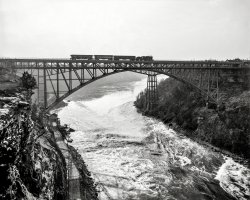
- Bay Street: 1904
- ... Bernstein. The American Hatter, September, 1903 .
Grand Rapids Furniture Company , 16 West Bay, in the Benedict block. Specializing in ... Posted by Dave - 01/01/2018 - 11:20am -
![Bay Street: 1904 Jacksonville, Florida, circa 1904. "Bay Street." Big Hosiery Sale To-day at Furchgott's! 8x10 glass negative, Detroit Publishing Company. View full size.
All I askis 15 minutes in Furchgott's with $100 in 1904 bills, and I'd never ask for another thing as long as I lived!
TodayFound this website while trying to find the address of the shot shown above. 130 W. Adams. Google maps shows building still there - but of course nothing like it was.
QuestionIs that an incandescent light hanging there, or an old style arc light?
[Carbon arc. -tterrace]
Benedict Block on West Bay
Bond & Bours Hardware, Shelf and heavy hardware, tinware, agricultural implements and sporting goods. The Metal Worker, May 3, 1902
Stuart-Bernstein Company, Hats, clothing and furnishing goods, in the Benedict building, 14 West Bay street, Jacksonville Fla. George W. Stuart and Emil Bernstein. The American Hatter, September, 1903.
Grand Rapids Furniture Company, 16 West Bay, in the Benedict block. Specializing in Mission furniture. American Cabinet Maker and Upholsterer, October 17, 1903.
Ludden-Campbell-Smith Company, Musical instruments. William Ludden, A.B. Campbell and J. Smith. Piano, Organ & Musical Instrument Workers Official Journal, February, 1908.
McCall PatternThe McCall Pattern Company, still in business, is a privately owned, worldwide company that designs, manufactures and sells sewing patterns under the brand names of Butterick, Kwik Sew, McCall's and Vogue Patterns, through fabric retailers and on their websites.
My Great-Great GrandfatherMy Great-Great Grandfather s the Stuart in Stuart-Bernstein! George W Stuart. So cool to have found this photo. My Grandmother (who will be 96 this year) remembered family stories about her Grandaddy Stuart owning this clothing store. He died in 1908 before she was born, just a few years after they opened the store. Really would like to find a photo of the two men in front of the store, but haven't been able to find such a thing!
(The Gallery, DPC, Florida, Jacksonville, Streetcars)](https://www.shorpy.com/files/images/SHORPY_4a11756a.thumbnail.jpg)
- Detroit Opera House: 1904
- ... the Ann Arbor, Pere Marquette and Wabash Railroads. The Grand Rapids and Indiana Railroad was chartered in 1854 to build a line from Fort ... Posted by Dave - 07/19/2012 - 10:23pm -
![Detroit Opera House: 1904 The Detroit Opera House circa 1904, starring an electric runabout out front. 8x10 inch dry plate glass negative, Detroit Publishing Company. View full size.
Detroit Conservatory MusicWhat, they were too cheap to spring for an "of"?
Digital sign againI've noticed that each time we've seen one of those "digital" signs it's been on or in front of a large theater, opera house or concert hall, the type of venue you'd expect the upper classes, rather than the hoi-polloi, to frequent. My speculation: it's something used to signal carriages for their ritzy patrons. Below: this one compared to ones at Philadelphia's Nixon Theatre and Academy of Music.
Update: Thanks to TomHe for confirming my speculation.
High Bridge?Look in the window of the Pennsylvania Lines shop. Is the picture on the easel that of the High Bridge of recent memory?
[Unfortunately, no. - tterrace]
Videochas PicThat's Horseshoe Curve, near Altoona, PA
Makes My Heart SingWhat a lovely building! I was born in the wrong era. I come to Shorpy everyday and I'm never disappointed with the photos here. I would hope this building is still standing. I absolutely love the honeycomb glass transom at the entrance door. I wish buildings of today had the details of old world craftsmanship. Sigh.
[Demolished 1966. - tterrace]
What is that thang?Sharp eyes as usual from tterrace, but I can't make out just how this configuration of three identical sets of light-bulb "dots" could be lit to form letters or numbers. The mysterious device's Academy of Music installation, at right, appears to include some kind of identifying signage on the end of the clapboard base beneath it. Dave, is your highest-res tiff file of this photo sufficiently clear to read that information?
[Not clear enough on the full LOC tiff, unfortunately. - tterrace]
Pennsylvania LinesThe Pennsylvania Railroad was a late arrival in Detroit, not gaining a direct entrance there until 1922, and then only by trackage rights on the Ann Arbor, Pere Marquette and Wabash Railroads. The Grand Rapids and Indiana Railroad was chartered in 1854 to build a line from Fort Wayne to the Straits of Mackinaw through Grand Rapids. It became part of the Pennsylvania Lines in 1869. It too had no direct connection to Detroit, relying on a connection with the Wabash in Ft. Wayne to get to the Motor City.
Identify car?Great picture! Can anyone identify that nifty little car?
The proverbial needleConcerning identifying the automobile, unless it was built by a select few makers, I doubt it can be positively identified.
During this period there were around a thousand automobile manufacturers in America alone. What we do know is that it's an early brass era runabout with tiller steering, semi-eliptical leaf springs at each corner, and wooden spoked wheels. That should narrow it down to about 50 manufacturers, some of which existed for only a few years.
Re: The proverbial needleI think I have identified the car. It's an AJAX ELECTRIC. I have attached a photo from an advertisement from 1903, for visual comparison.
[Here they are together. Among other differences, note the absence of front leaf springs. - tterrace]
Wright & KayThe jewelry firm of Wright & Kay (big sign atop building) was formed in May 1906 by Ohio native Henry M. Wright (a Civil War veteran as a member of Co. B, 85th Ohio Volunteers) and John Kay, who was born in Scotland. They were jewelers, opticians, importers and dealers in watches, clocks, diamonds, marble statuary, silver and plated ware and fine stationery, and they manufactured watches and other products under their own name. Recently some Wright, Kay & Company watches were auctioned at Christie's.
About that haystackMy first thought when I looked at the full-size image was Studebaker. After further research the answer will have to be no, they were building a Runabout with very similar bodywork and proportions in that era but it had major mechanical differences from this machine.
As BradL said, this was a time when literally hundreds of companies ranging from blacksmiths, to buggy shops, to established manufacturers of sewing machines and other mechanical equipment, all took a fling at the automobile.
MysterymobileI'm almost certain it's a Waverly Runabout, built in Indianapolis. I have a current-day photo but it's somebody's property. Note its steering is via a front tiller whereas the Studebaker has its tiller on the side.
Re: Digital sign againA carriage call indeed. Picture below shows numbers lit.
WaverleyDon Struke has it, I found a vintage Waverley advertisement that certainly seems to match the mystery car closely.
HorsesCalm and unaware that they were about to be unemployed in very short time.
(The Gallery, Cars, Trucks, Buses, Detroit Photos, DPC, Performing Arts)](https://www.shorpy.com/files/images/SHORPY_4a11547a.thumbnail.jpg)
- Icemobile: 1905
- Circa 1905. "Grand Trunk car ferry crossing the Detroit River in winter." 8x10 inch dry ... not seen before. The Lansdowne was built in 1884 for the Grand Trunk Railway. She was powered by a pair of horizontal low pressure ... cars have survived. One that I know of for sure, Cedar Rapids, is operational and sometimes used on excursions. She would be a true ... Posted by Dave - 08/02/2012 - 5:25pm -
![Icemobile: 1905 Circa 1905. "Grand Trunk car ferry crossing the Detroit River in winter." 8x10 inch dry plate glass negative, Detroit Publishing Company. View full size.
Pullman carsSome interesting information and illustrations here. Seems there are examples at his museum, and a few in other countries.
Titanic Worries!"What was that, Hon? You want me to sit with you in the rail car? No thanks. I think I'll just stay out here in the lifeboat if you don't mind."
Just Chillin' on the VerandaBut what a smoke screen those poor passengers had to endure. I wonder what sort of sturdy craft the photographer was perched on in order to "get the shot." The hardy occupants of the coach nearest the camera had apparently already weathered a nasty storm on the rails; that car's frosted like a wedding cake!
[The "sturdy craft" was land. - Dave]
ExtraordinaryWhat a captivating and dramatic riverscape.
Maybe the League of Extraordinary Gentlemen are heading out on another adventure?
VestibulesNice shot of the railroad ferries that plied many waters on the Great Lakes. Similar ships were used, for instance, on the Straits of Mackinac for decades.
The picture is a great illustration of one of the real innovations in passenger cars - vestibules at the ends of the cars that allowed passengers to move from car to car through the train while it was in motion. Better yet, the photo shows the car on the left with the earlier, so-called open vestibule (still had some open platform) while the car on the right was the newer, fully-closed vestibule. Not only did the vestibules make moving between cars easier but the Pullman Company (which invented and patented them) tried to convince passengers that they strengthened the cars in the event of a collision. The tighter coupling was said to prevent the cars from telescoping into one another. This had been a real problem in the old open-platform cars. It was such a great idea that the designs were quickly knocked off by the other passenger car companies and it became the standard of the industry.
Thanks DaveI am planning on building a model of the Lansdowne and the definition on this photo shows detail I have not seen before. The Lansdowne was built in 1884 for the Grand Trunk Railway. She was powered by a pair of horizontal low pressure engines working at 55 psi, until some engineer forgot to drain one on startup in 1971 and blew the cylinder head off it, instantly converting it to a barge.
She was pushed by a tug for a few years then laid up and converted to a restaurant on the Detroit waterfront. Her hulk still rests partially submerged in Erie, PA. Being a sidewheeler with each paddle capable of independent operation, she was considered a very good ice boat.
RivetedJust what I was thinking, Jeff! Very steampunk looking. Great shot.
Here's How It WorksThe couple on the Stern may be setting the scene for a film to be made some 90 years later. The Director electing to use a younger pair and move them to the front of the ship, many of the cast and the movie itself would eventually win Oscars and VHS tapes would be handed out to purchasers of Happy Meals.
The Addams Family at SeaLooking at those wheelhouses, I don't think I've ever seen a ship built with a mansard roof.
ParticulatesThe lack of pollution control back in the day is startling. The amount of thick black smoke would certainly not be tolerated today. It would take several more years until emission control standards would be adopted.
[Several more decades! - Dave]
The Lansdownewas towed from Erie to Buffalo in 2008 and broken up there that year.
Life as a restaurantPictures of the Lansdowne as a floating restaurant on the Detroit waterfront are hard to come by (see below). She lost one side wheel and a pair of funnels, and had a steel structure built on top with two old railroad observation cars at one end. The interiors (and exteriors) were just cheap 1980s ersatz "luxury," with little connection or even acknowledgment of her Victorian past. It could have been built on any old barge and been the same. By the end of its restaurant career, it was dirty, poorly managed and had awful food.
Photo SourceTry as I might I can not locate this image on the LOC site. Did you obtain it from them? I'd like to play with the full size Tiff copy they usually have on the site.
[It's here. You can find these by searching LOC for the filename (for this one, "4a15742" -- right-click on the Shorpy image, choose "properties" or "view image info") - Dave]
Restaurant Observation CarsThe observation cars on the photo of the Lansdowne as a restaurant photo that bigguy1960 posted are a pair of Milwaukee Road Skytop Observation Cars that were built in 1949 when they re-equipped their Hiawatha trains. Ten of these were built, six in the original design with the extended skypod observation area and four with a shortened skypod; the latter class are the cars on the Lansdowne. They were withdrawn from service in 1970. Apparently the railcars were undamaged when the Lansdowne sank at Erie, but couldn't be salvaged intact and were each cut into three pieces. There was reportedly an effort underway to salvage them to make one complete car out of the two but I have no knowledge of whether this was carried out.
Update: To answer swissarch's question, several of the ten Skytop cars have survived. One that I know of for sure, Cedar Rapids, is operational and sometimes used on excursions. She would be a true sister of the cars on the Lansdowne. The car is owned by a group called "Friends of 261" and can even be rented for whatever reason. At least two other cars Coffee Creek and Dell Rapids either still exist or are in the process of being restored.
ExtraThat's what I'd pay to ride in one of those Obervation Cars. It must have been truly exciting to be in one of those thundering along at about 80 mph, watching the world rush by. Shame they're lost; were any saved?
Spectacular shotQuestion for the boat engineers. It seems that a lot of the inland vessels back then used paddlewheels. What is the advantage of a paddlewheel over a screw? Why were they so popular then and not now? And why are some sidewheelers and some sternwheelers?
Postcard based on the photographFound on the Web.
[Very nice -- it looks like a watercolor. - Dave]
(The Gallery, Boats & Bridges, DPC, Railroads)](https://www.shorpy.com/files/images/4a15742a.thumbnail.jpg)
- Candy Kitchen: 1908
- Grand Rapids, Michigan, circa 1908. "View of Monroe Street showing Hotel Pantlind." ... more middle of the day, noontime, shadows to me.
Amway Grand Plaza The old Pantlind Hotel is now the east portion of the Amway ... Posted by Dave - 08/13/2013 - 4:09pm -
![Candy Kitchen: 1908 Grand Rapids, Michigan, circa 1908. "View of Monroe Street showing Hotel Pantlind." Not to mention the Candy Kitchen and Ice Cream Parlor. 8x10 inch dry plate glass negative, Detroit Publishing Company. View full size.
Handlesbar NetI like the net on the bike, and note correct usage: two handles, one bar.
[Kind of like teethbrush, or eyesglasses. - Dave]
Don't use the tower clock to sync your pocket watchThe clock on the tower says that it is 9:34, but the shadows, especially the awnings on the hotel, appear to be more middle of the day, noontime, shadows to me.
Amway Grand PlazaThe old Pantlind Hotel is now the east portion of the Amway Grand Plaza Hotel.
NowadaysIt would be called Kandy Kitchen.
Spacious Streetscape It's positively capacious! No bus shelters, benches, trees or overflowing litter receptacles. There aren't even any parking meters or lampposts to properly lock those newfangled bicycles against.
So many peopleBy my count there are over 40 people (and one dog) visible in the picture. That's more than in most cityscape pictures, even ones in much larger cities than Grand Rapids.
Cover StoryWhat's the story behind the tarps that are covering some of the store front windows?
(The Gallery, Bicycles, DPC, Streetcars)](https://www.shorpy.com/files/images/SHORPY_4a23403a.thumbnail.jpg)
- Uncle Fred: 1905
- Grand Rapids, circa 1905.
Uncle Fred wasn't my mother's uncle, nor was he Judge Maynard, as he often referred to himself in and around Grand Rapids, Ann Arbor, and Owosso, Michigan. My family called him Uncle Fred ... Posted by CarlosJ - 07/02/2018 - 6:57am -
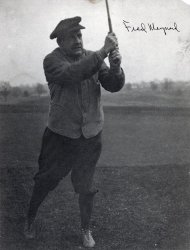
- Car 25: 1905
- ... a toast from yon window?
GR&I Look like Grand Rapids & Indiana cars in the background. Another railroad providing service ... Posted by Dave - 08/05/2012 - 4:27pm -
![Car 25: 1905 Circa 1905. "Pere Marquette Railroad parlor car No. 25, exterior." 8x10 inch dry plate glass negative, Detroit Publishing Company. View full size.
Details of CarThe following details come from the book, Mr. Pullman's Elegant Palace Car by Lucius Beebe, 1961:
Superb examples of American Car & Foundry craftsmanship are these two palace cars frin the collection of Arthur D. Durbin [pictures differ from what Shorpy shows]. The Pere Marquette's parlor-cafe No. 25 was in built at A.C.F.'s Jeffersonville shops in 1903 and assigned to the Northern Michigan vacation service on trains No. 1 and 5, and Nos. 9 and 10, the Resort Special. Of this train the public timetable for 1905 of the Great Central route of which the Pere Marquette was a component, says, 'Trains No. 1 and 5 will stop at Little Manistee River (Fishing Camp) on signal,' an index of casual operation in good old summer days. The car was characterized by a curved rear bulkhead with plate-glass windows to match, giving onto an observation platform of uncommon depth.
The Little Manistee River is on the western shores of the lower peninsula of Michigan between Ludington and Frankfort.
GarbageWhat is a bit surprising to me is the amount of litter all over the ground. I'd think a railroad wanting to show off its equipment would want the best representation possible. Or maybe somebody just took a snapshot of a lone car on a siding.
[8x10 glass negatives aren't what most people would consider casual photography. Made with big heavy view cameras on tripods. - Dave]
CheersIs someone proposing a toast from yon window?
GR&ILook like Grand Rapids & Indiana cars in the background. Another railroad providing service to Michigan's "Sportsman's Paradise." Could be at Muskegon or Grand Rapids. I think the GR&I and PM crossed paths at these cities, maybe others.
It's all in the detailSo nice to see the livery and striping details on these Cars. The flourished ends are a nice touch, tradesman at work. In our modern age it is really a treat to see great resource for signpainting restored cars such as these.
HandshakesI can't remember ever seeing a three line air system on any rail cars I am familiar with. Nowadays only one is used.
I have no doubt someone will come along shortly with a perfectly reasonable and technical explanation for us all.
The HosesThe three hoses you see are, from smallest to biggest, the train signal line, the air brake trainline and the steam heat line. The air line for the signal connected to a whistle in the locomotive cab so that the conductor could, through a series of long or short tugs on the valve, signal to stop at the next station, supply more steam for heat, etc.
The air brake line carried 90 to 110 psi compressed air and by reducing the pressure in this line would apply the brakes throughout the entire train.
The third and largest hose supplied steam used for heating the cars, a big improvement over the coal stoves used previously which tended to ignite these varnished wooden cars rather quickly in a wreck!
Multiple HosesOne hose was the air brakes. A second was steam heat. The third may have either been for steam (connections look similar) or for drinking water. Only the air brakes would have been needed on a freight car.
Air Signal lineOne of those extra air hoses on the end of the car is probably for the train air signal line. The other line I am not sure about without looking at some old books I have. The cars probably had stoves for heat and it's not the right size or type of connection for steam heat. It seems like I should know, but I just cannot recall what the third line would be for.
Three LinesThe three lines most likely are: air brakes, steam heat and train signal line. The signal line permitted the conductor (by a small valve located on the bulkhead) to give whistle signals to the locomotive crew.
Re: HandshakesThanks to all who jumped right in with explanations for my previous comment. Shorpy readers are the best! No question remains unresolved very long here. I learn something new every day.
Thanks Dave, for this entertaining and educational site.
(The Gallery, DPC, Railroads)](https://www.shorpy.com/files/images/4a20382a.thumbnail.jpg)
- Autumn Leaves: 1899
- ... in Google Maps :*(
My Mama Told Me Mom grew up in Grand Rapids and would frequently tell us kids stories about "beautiful Michigan". I ... Posted by Dave - 07/19/2012 - 12:59pm -
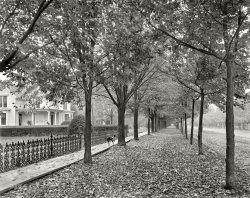
- Appleton Here We Come: 1962
- ... from Washington National (home) to my aunt and uncle's in Grand Rapids. As I was only about 10 at the time and traveling alone, my parents ... Posted by Dave - 01/14/2013 - 5:10pm -
![Appleton Here We Come: 1962 October 1962. "Wisconsin plane trip." En route to Appleton, it's Mad Men with choreography. This would seem to have been a business trip made by Kermy and Janet's father from Baltimore. 35mm Kodachrome slide. View full size.
A long-vanished airlineNorth Central Airlines is now three generations into the past. It became Republic Airlines after a merger with Southern Airways in 1979, Northwest Airlines acquired Republic in 1986, and Northwest became part of Delta Air Lines in 2008. It's possible that there may be a few pre-1979 North Central employees still working for Delta, most likely flight attendants as they often stick around for decades.
The aircraft appears to be a Convair 340, one of the last of the pre-jet airliners.
Douglas DC-3First operationally flown in 1935, the Douglas DC-3 became a real workhorse of commercial airlines and of the U.S. Air Force as as the C-47. Some are still being flown today, mainly by smaller third world airlines. A few of the earliest DC-3s are still flying about 75 years after they were manufactured.
North Central Airlines was founded as Wisconsin Central Airlines in 1944. The name was changed to North Central in 1952 and headquarters moved to Minneapolis. North Central flew as many as 32 DC-3s during its existence. The airline ceased operations in 1979.
DC-3 StairsMy dad loved DC-3s and had one-- it might have been the C-47 version-- in the late 1960s. One day he tripped or caught his foot or something while coming down those little steps and broke his arm when he hit the tarmac.
The doctor asked him how he had injured himself, and my dad, a man of few words even when he wasn't in pain, replied he had fallen out of an airplane.
The doctor said, "Well, I don't know how high the plane was, but you got off pretty easy!"
DC-3/C-47The DC-3/C-47 is my favorite airplane; I built countless model variants as a kid. The North Central livery is particularly nice. More detail here.
MemoriesI can remember DC-3s flying over our small-town house to the local airport when I was a kid in the early 1960s. They seemed really huge to me at the time.
Whiskey CentralI well recall my father's jokes and asides regarding North Central Airlines -- or Whiskey Central, as he and not a few others preferred to call it in the early days. We lived in Eau Claire, Wis., home of Presto Industries and 25 below zero temperatures. As a traveling salesman for Presto, dad would occasionally ride Whiskey Central to some distant city on business. Be it the dead of winter, he never failed to carry a hip flask filled with Early Times, which he affectionately referred to as "my infallible portable heater."
He further noted, as I recall, that the stewardesses were all males, and very likely descended from hardy Viking stock accustomed to Icelandic weather. Atop their uniforms they wore fur-lined coats adorned with turned-up mink collars.
I also vividly remember standing beside my mother on the tarmac and waving back at my father as he paused halfway up the airplane ramp. And then remaining rooted to the spot until the speck in the sky disappeared from sight.
Jim PageGreat story; your dad sounds like my dad. Few words were too many.
N25651Click to enlarge. Photos by Kermy's dad of the plane in the main photo above.
AmazingThe old Gooney Bird is still in use to this day. What a great aircraft!
[The only thing still in use is the number N25651. It's assigned to a 21-year-old hot-air balloon. Our DC-3 was deregistered in 1990. - Dave]
Oh, I really thought there were some still in use.... you mean none flying
worldwide?
It'll get you there -- eventuallyI flew North Central in the summers in the early 70s. Convair 340s from Washington National (home) to my aunt and uncle's in Grand Rapids. As I was only about 10 at the time and traveling alone, my parents booked me on North Central as there were no plane changes. It did, however, stop at Philadelphia, Pittsburgh, Cleveland, Detroit and Lansing along the way.
Please tell methis plane had a lavatory.
A very old DC-3In fact not a DC-3 as such but a DST (Douglas Sleeper Transport) the original version built long before WW II with 16 sleeping berths for night flights, convertible to 24 seats for day use. It had Wright Cyclone engines not the more familiar Pratts.
N25651 had a long career. It was impressed into the army as a C-49 and postwar served not just North Central but also Galaxy, Holiday Hunters, Shorter and finally Bahamasair. It was last reported derelict at St Thomas in the US Virgin Islands.
PBA/Naples AirlinesIce Gang's comment is cool; living in Naples back in the 60s and being at the airport with my pilot dad all the time, I'd see those PBA/Naples Airlines planes a lot. At some point prior to those days, Provincetown/Boston Airlines had absorbed the old Naples Airlines, unless I remember it wrong-- which isn't impossible!
I remember hearing that old Naples Airport was the site of the first U.S. airplane hijacking; a fellow hijacked a plane there to fly him to Cuba. Now, I'll leave it up the the brilliant folks here on Shorpy.com to let me know if that little tidbit is correct or not.
I think it's really a DC-3I'm pretty sure it's not a DST. The DST's boarding door was on the right. It had auxiliary windows above the regular ones so the upper berth didn't feel too closed in, and Dave's picture of the full exterior doesn't show those.
Route of the Blue Goose"Route of the blue goose" was the tag, like "Wings of man" for Eastern, in the ads.
All dressed up-And somewhere to go. I wonder at what point travelers began dressing down for flights; it used to be an occasion and people dressed accordingly. I remember flying on the west coast's PSA in those days and always wearing a suit and tie, even as a teenager. We flew to from home in San Diego to Hollywood-Burbank and back for under $20 and still had money left for shopping trips to Desmond's and Silverwood's, nice Los angeles area clothing stores.
DC-3 hoursMany years back I flew from Tampa to Naples Florida on PBA airline, I was the only passenger and the pilot told me this DC-3 had the most hours of any DC-3, 84,876 hours, the plane is being restored in Washington and is still flying with over 91,400 hours (10 1/2 years in the air) Canadian Pacific Airlines had a flying Canada goose as it's logo, only it was flying to the right.
Dressing upI can only guess that the "dress code" for flying went away in the mid to late 60's (at least on the west coast). My first plane trip was in 1970, from Sacramento to L.A. on PSA, and I don't recall donning anything more than what I'd have worn on any given day (I was 17, so somewhat attuned to these things). But maybe I was just a slob.
Eight Years LaterI have a North Central flight schedule dated January 1, 1970, with 22 tiny print pages of flights. They really covered the Upper Midwest.
About that Dress CodeI don't think that they're dressed up just because they are flying. It appears to be a business trip, so the gentlemen are dressed just as they would if they were going to the office. This is still common practice for some companies today - if you're traveling for the company, you follow the dress code that's in place. But general office dress codes are less strict in many businesses now.
I flew in and out of Appleton on DC-3sYup---I flew from Appleton on a DC-3 to Chicago via Milwaukee when I went into the Navy in 1960. I would come home on leave to Appleton by air and through Chicago via Milwaukee--I'd arrive in a DC-3. Sometimes as few as two passengers would be on board from Milwaukee to Appleton. It was a bouncy ride from Chicago. History will show the DC-3s on North Central Air were tough birds--one collided with a small private plane between Chicago and Milwaukee---and carried the other craft all the way to safe landing in Milwaukee---the small plane imbedded in the DC-3s port bow. I am not sure the DC-3 views shown on Shorpy's are at the present airport location west of town or the one I remember on the north east side off Ballard road.
Dressed to FlyWe flew often during the 60s and 70s and I remember my mom making sure we all wore Sunday best - all five of us kids. In fact when packing our bags, the question was always posed to us - "What are you wearing on the plane?" It wasn't until the 80s that it was about dressing for comfort and then of course it morphed into dressing for airport security checks.
The connection between dress and self-respect as well as respect for the occasion has deteriorated quickly since the baby-boomer generation. Soon we'll all be wearing shorts and flip-flops to the office just like many do at church these days.
1975 versionHere's a picture of the DC-3 from 1975:
http://www.airlinefan.com/airline-photos/6642431/Shorter-Airlines/Dougla...
Never heard of "Shorter Airlines" but the picture says it was taken in Miami.
http://www.michaelprophet.com/imagesSanJuan1985_1989/55.jpg
This might be the same plane, it matches the paint scheme from the 1975 picture, but the registration number is covered by the bushes.
Sad it see it in that shape.
(Aviation, Kermy Kodachromes)](https://www.shorpy.com/files/images/SHORPY_Kermy086.thumbnail.jpg)
- Furniture City: 1908
- Grand Rapids, Michigan, circa 1908. "Phoenix Furniture Co., Fulton and Summer Sts." ... information, 1) 1987: Manufacturing complex donated to Grand Valley State University, and 2) the photo in the link shows railroad ... Posted by Dave - 07/27/2022 - 7:21pm -
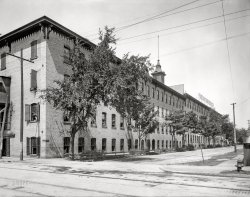
- The Hat That Talks: 1908
- Grand Rapids, Michigan, circa 1908. "Monroe Street." Your headquarters for chatty ... at Pearl Street and Monroe. A modern branch is here in Grand Rapids just rear-right of the viewer. Monroe Avenue has changed over the ... Posted by Dave - 06/19/2018 - 12:28pm -
![The Hat That Talks: 1908 Grand Rapids, Michigan, circa 1908. "Monroe Street." Your headquarters for chatty chapeaux. 8x10 glass negative, Detroit Publishing Co. View full size.
Eliminates the middlemanNo need for a person to "talk through his hat." Now the hat can do the talking for him.
Nat'l City still nearbyInteresting to see the National City branch at Pearl Street and Monroe. A modern branch is here in Grand Rapids just rear-right of the viewer. Monroe Avenue has changed over the years, from a road to a pedestrian mall, back to a road. Still a good variety of historic structures along its path, though the corner buildings and distant Herpolsheimers building are gone.
The lady in whiteThe city looks like a grimy place, but somehow the lady in the white -- or at least light coloured -- dress on the street corner manages to keep her apparel squeaky clean.
QuestionsOK, can anyone elaborate on "The Hat That Talks"? And the guy with the chair under the umbrella in the middle of the street -- a streetcar dispatcher?
IllusionsAs I scrolled across the enlarged version of this photo, I noticed the hat on the woman in white on the street corner. Did her hat have two tiny people on top of it? That would explain the talking hat part. No, it was people in the background, giving that illusion. As I scrolled down, I noticed the horse turds in the street and the fact that the woman was holding something that gives the illusion she is about to be hit by a flying horse turd (at least I HOPE it's an illusion).
There she is in her lovely white dress, just waiting to cross the street, and 103 years later people are seeing tiny talking people on her head and large turd flying at her. It makes me wonder what people might notice about my own candid photos 100 years from now.
TodayThe photographer is looking basically southeast. The buildings on the right (south) of Monroe are mostly all gone; now Rosa Parks Circle is there, a downtown gathering spot for open-air concerts and ice skating in season.
View Larger Map
1908 DentistryBy the time you walk up 5 flights of stairs you will have forgotten about your toothache.
Talking hats serve an important purposeWhen you place one on your head, it tells you which branch of Hogwarts you are a member of: Gryffindor, Hufflepuff, Ravenclaw or Slytherin.
Umbrella (not) manre: Dennis M's comment: if you look at the shadows, you'll see that the guy bending over is several feet away from the chair, so I don't think the two are necessarily associated. I'd say it's more likely he's related to the overflowing trash can and broom at the curb - possibly collecting some detritus on the street. I'm going with your speculation that the umbrella/chair has something to do with a streetcar functionary.
[Perhaps the fellow over by the streetcar. Umbrella bears the name of Something Milling Co. - Dave]
(The Gallery, DPC, Streetcars)](https://www.shorpy.com/files/images/SHORPY_4a23402a.thumbnail.jpg)
- Nifty Nook: 1940
- ... the second of seven kids born to Dutch immigrants in Grand Rapids, Michigan, whose eighteenth birthday fell on the very day the Nazis ... Posted by Dave - 07/26/2018 - 3:02pm -
![Nifty Nook: 1940 May 1940. "High school students crossing the street. Phoenix, Arizona." Medium format negative by Russell Lee for the Farm Security Admin. View full size.
Another view from 2017I have no idea how the "TimeandAgainPhoto" post knew the location of this photo. I looked for some clue (i.e street signs) but could not find anything. But thanks to their information I was able to find this street view from about the same angle as the original with the aforementioned school on the opposite side of the street from their post.
Same differenceThat 35-cent Spanish Dinner seems so inexpensive but it's the same as $6.40 today.
+68Below is the same perspective from May of 2008. The view is looking southeast from the corner of what I believe was Sixth Street (which no longer intersects here) and East Van Buren Streets. The large building in the background on the right is the Monroe School at 215 N. 7th Street. Constructed in 1913, it remains but can no longer be seen from this vantage.
Fill 'er upYou can have a hamburger, five different kinds of soft drinks, and ice cream - or you can splurge on a Spanish Dinner. Decisions, decisions.
RC ColaI remember when i was a child in the 60s RC cola was the king of the marketplace in my hometown of Robbinsville N.C. It is kinda sad that the brand has been lost. The drink still exists, but the taste is gone.
Scoping 'em outLove the guy in the road checking out the two chicks walking away. The stop sign seems like good advice.
ImpactThanks for all the amazing gifts you Shorpy folks have presented over the years, Dave, but I need to tell you that never has a photo affected me like this one.
I see these high-schoolers of 1940, and think of my late father, the second of seven kids born to Dutch immigrants in Grand Rapids, Michigan, whose eighteenth birthday fell on the very day the Nazis invaded The Netherlands: May 10, 1940.
He'd recalled that GR's southwest side, populated at that time mostly by folks of Dutch heritage, was eerily hushed during those months — "way too quiet," as he described it. Frustration, anxiety and fear swirled through the community, with many Dutch-Americans unable to obtain any information on the well-being of friends and loved ones living in the "Old Country".
I observe these young ladies crossing the street, and they don't seem to be the happy-go-lucky, carefree kids I'd expected to see. Like they know something's coming. Something dark.
School crossingThe young man in the middle of the street is not admiring the young ladies walking away, he is the school crossing guard. He is operating the stop sign for a safe crossing for all his classmates. You can see the base of the unit between his feet.
PUHSView is looking southeast from the northwast corner of 7th Street and Van Buren. Behind the camera is Phoenix Union High School. It is the high school which many in my family attended up to 1960 and which I attended briefly in 1964 before East [Phoenix] High School construction was completed. In the background is Monroe Elementary School which my grandma Callie B. Wilkins [nee Jones] claims she attended. It was briefly an AFEES (Armed Forces Entrance and Examination Station) in the 80-90's. The PUHS campus has been replaced by office buildings with some of the original classroom buildings serving as a University of Arizona extension.
600 Block of Van Buren, Not the 700 Block?A search of Newspapers.com reveals that the Nifty Nook was at 601 E. Van Buren (as of November 1939) and Sunnyland Bakery was at 605 E. Van Buren. This suggests that the cross street at the right is 6th Street, not 7th. The stop sign at the extreme left edge of the photograph is probably 7th Street.
6th Street does not exist at Van Buren any more, but the screenshot posted by TimeAndAgainPhoto, of the ASU downtown campus, is closer than the one from ceraurus of 7th Street.
["Ceraurus"? - Dave]
Clarification: The screenshot that user "ceraurus" posted in a previous comment.
"Arizona Highways" articleThis Russell Lee photo was recently the lead photo in the February 2022 issue of "Arizona Highways" It was spread across pages 28 & 29. The article featured photos of Phoenix by Russell Lee in the 1940s.
I just received the April 2022 issue of "Arizona Highways" and the Editor's Letter on page 2 discusses a recent conversation he had with one of the girls crossing the street in this photo. Her name is Joyce Cambell-Wing, she is the girl in the white dress closest to the 7UP sign in the photo. Her conversation with the editor goes into a lot of detail about her memories of the early '40s.
(The Gallery, Eateries & Bars, Russell Lee)](https://www.shorpy.com/files/images/SHORPY-8b24813a.thumbnail.jpg)
- Olds Motor Works: 1908
- ... are pretty easy to come by, but Saginaw/Flint/Lansing/Grand Rapids/Muskegon/etc. are tough to find.
Speed Limits Those signs speak ... Posted by Dave - 08/14/2012 - 12:58pm -
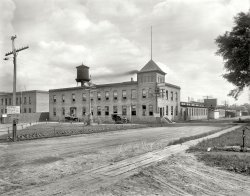
- Franklin Street School
- ... it was taken in the 1930s at the Franklin Street School in Grand Rapids, Michigan, where she was the principal.
Bertha’s December 1945 ... Posted by CarlosJ - 03/30/2011 - 3:45pm -
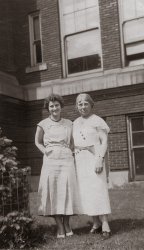
- A Banner Day: 1911
- ... of anywhere in the city by bus or streetcar. Then moved to Grand Rapids, Michigan, where you were extremely lucky if you could get within two ... Posted by Dave - 01/23/2018 - 10:12pm -
![A Banner Day: 1911 Cleveland, Ohio, circa 1911. "Public Square -- Cuyahoga County Soldiers' and Sailors' Monument." With flags and bunting much in evidence. 8x10 inch dry plate glass negative, Detroit Publishing Company. View full size.
A Newfangled Auto? Who Needs One!I count at least 15 streetcars in one photo. Maybe I missed a couple.
StreetcarsThere are quite a few streetcars in this scene. I love the May Company building on the far right.
Accident?What's going on in front of the streetcar on the left side middle? It looks like a crowd of people gathering, and the wagon next to it seems to have dumped its load all over the street. Maybe someone got hit?
A newspaper feeding frenzy?I interpret the gathering around the wagon with half its load on the ground as a delivery of newspapers. The small crowd has gathered to buy the latest edition "hot off the press."
Those were the days of newsboys selling right on the streets!
The Shorpy Sleuths can tell us if it's a morning, afternoon, or evening edition by studying the shadow patterns.
[Whatever it is, it's not newspapers. - Dave]
Hometown PrideYep, the 1911 date is right there. Time of day via shadow length seemed like late afternoon but squared up by a view of the clock on the May Co. building in the upper right: 3:10 p.m. The bunting is for a D.A.R. reunion that summer.
Large stone building in the center was completed 1910 and is extant. The Soldiers' & Sailors' Monument (center right) was completed in 1894 and is also still standing, even after a recently finished redo of the whole of Public Square.
Here's a Shorpy photo from the opposite direction 11 years earlier: https://www.shorpy.com/node/17589
Keep up the good work ... yer feeding my habit !
15 StreetcarsAnd not a single one named Desire I'd bet.
Hey 19is my streetcar count. With that many, it would be no problem to get around! I lived in San Francisco for a while, and could get within three blocks of anywhere in the city by bus or streetcar. Then moved to Grand Rapids, Michigan, where you were extremely lucky if you could get within two miles of where you wanted to go. If Grand Rapids was anything like this scene, I'd have never needed a driver's license!
Wayward Implements"I am so tired of carrying this ladder. That's it, I quit."
A Small Bit Of Trivia...Down in the lower left hand corner of the picture would be where Ralphie and his family watch the Christmas Parade in the film, 'A Christmas Story". And also, the four squares that make up Public Square in this picture have been remodeled into two large ones; Ontario Avenue no longer goes all the way through the square.
CEICºThe Cleveland Electric Illuminating Co. had his offices in one of the buildings in the middle, at 75 Public Square.
Here's a square related to them:
(The Gallery, Cleveland, DPC, Patriotic, Streetcars)](https://www.shorpy.com/files/images/SHORPY-4a25315a.thumbnail.jpg)
- Meanwhile, Back in Petoskey: 1900
- Petoskey, Michigan, circa 1901. "Grand Rapids & Indiana R.R. station." 8x10 inch dry plate glass negative, Detroit ... Posted by Dave - 08/10/2012 - 12:05am -
![Meanwhile, Back in Petoskey: 1900 Petoskey, Michigan, circa 1901. "Grand Rapids & Indiana R.R. station." 8x10 inch dry plate glass negative, Detroit Publishing Company. View full size.
Always a first hereNever have seen a boat on a baggage carrier before.
Engine/TenderI'd like to see that engine and tender from the side; it appears that it's a commuter run (from the crowd on the platform) but it must run in reverse a lot because of the cow-catcher on the tender. No turn wye at either end of its run? Railfans - help?
Typical Trolley StopOk typical turn of the century trolley stop. two trolleys numerous interesting people, wait a second go back the sort of dapper guy in the foreground with the lapstrake skiff on a hand truck. Excuse me buddy but you can't take your fishing boat on the trolley even if you pay 2 fares.
I am really trying to figure this one out and just what is he doing with the boat at a trolley stop, we will probably never know.
[He's taking it (or sending it) somewhere else. This is, as noted in the caption, a railroad station, not a a trolley stop. - Dave]
Sorry Dave I was only looking at the Trolley that was probably bringing people to the train. But on another note, why is there a man sitting in the boat? is he part of the shipment?
Take a ride on the GR&IClick to embiggen.
It's a double enderIn this era about the only locomotives with big headlights on both ends were either switchers or double-enders. The catcher on the rear does indeed indicate this hog has regular assignment on a job where half of the trips are backward.
The earlier picture of Petoskey shows a train ready to leave here, probably with this very engine, running in reverse.
If you search an old GR&I timetable from this time, you'll find out where this train was going. It probably ran to some branch terminal that had no turn facilities, or it may have ended its run at some main line station that had no turn facility.
One of the most famous short line steam roads today, Pennsylvania's Strasburg Rail Road has been doing that from the start; there never have been turn facilities at Strasburg.
Next StopYou are right, the engine is designed to run tender first at the head of the train. The likely destination is Harbor Springs, which was served by a branch line diverging just north of Petoskey. Another depot photo shows a main line train on the track adjacent to the station, and a branch line train with a similar engine, tender first, on the next track. In some eras, through Pullmans were carried from Cincinnati and Chicago, dropping wealthy tourists close to their lake front hotels.
Tank EngineThe loco is a tank engine -- it has no separate tender. Both the coal bunker and water tank are carried on a rearward extension of the loco frame, in this case on a four-wheeled truck. It is a type of engine commonly but not always correctly referred to in the US as a "Forney." They were designed to be run safely at track speed in either direction without turning, making them well suited to suburban trains.
Railroad expansion plansCompare this one to the Petoskey depot view posted a few days earlier. Station platform is longer and has a new roof structure in 1908. New station platform surface. More tracks about the depot -- the expansion process is evident in this picture with rock wall stone on the flat cars. Extra track is to be added and the water spout seems to be missing in '08 shot -- as is the station semaphore signal. Engine number 4 is backing toward you in this view -- and may be the engine in the foreground in the 1908 view -- a number 4 seems to be on the forward headlight number board of the 4-4-0 in the '08 view though it is not clear. The engine cabs are a bit different -- back cab windows are at a higher level in the 'o8 photo. Rolling tail light shade is missing in this shot but evident in the '08 view.
Suburban Station at PetoskeyThis is the GR&I (later PRR) suburban station at Petoskey, which operated during the summer months for tourists headed out for the day at Walloon lake or Alanson. The steam engine pictured could operate in either direction (without turning on a wye track) to facilitate quick turnarounds. This suburban station was located about two blocks to the south from the main passenger station which still exists in 2011, without passenger train service.
"cowcatcher"?? Puleeze!!The proper term used by railroad personnel is "pilot".
The "station semaphore" is properly called "order boards" and the "water spout" was commonly called a "standpipe".
Possibly, in other parts of the world, these other terms may have been different, but "cowcather": never!
(The Gallery, DPC, Petoskey, Railroads)](https://www.shorpy.com/files/images/SHORPY_4a07903a.thumbnail.jpg)
- Old Salts: 1910
- ... but it is a LOT nicer than the famed PEPPER MINES of Grand Rapids.
Those guys must have been insanely thirsty all the time!
... Posted by Dave - 08/08/2012 - 1:33pm -
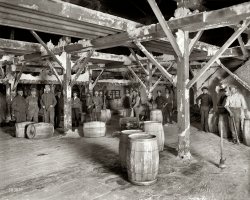
- Heavy Duty: 1918
- ... version) built by the Couple-Gear Freight Wheel Company of Grand Rapids.
From 1918 to at least 1922 Fageol designed trucks to replace the ... Posted by Dave - 06/10/2016 - 11:25am -
![Heavy Duty: 1918 UPDATE: click here to see this beast in action!
"Fageol heavy truck assembly -- Oakland, California, factory, 1918." 8x10 inch dry plate glass negative by the Cheney Photo Advertising Company. View full size.
WOW!I'd like to know what this truck was for. Being oil-electric it must have had a huge weight like a locomotive only on rubber. Can't seem to search out anything this heavy on the web.
[It looks like the cab for a crane or excavating shovel. - Dave]
Is this the finished product?I did a search for Fageol shovel and this is what I found.
[Maybe you forgot to click "attach." - Dave]
Perhaps a locomotivefor some kind of articulated 'road train', scaled up from the passenger carrying vehicles that Fageol built for the Panama-Pacific exposition in 1915.
Here's a patent for the hitch design that's seen in the photograph...
http://fageol.com/F-Patents/US1407019-VCplg.pdf
There appears to be a hitch on each end of the chassis.
The machine in the picture seems to have four wheel steering and most likely an electric drive powered by the motor/generator up top. Maybe it was a special WW1 military contract.
Flexible Road Train engineOne possibility is this patent # 1,226,962.
R. B. FAGEOL.
FLEXIBLE ROAD TRAIN.
http://www.fageol.com/F-Patents/US1226962-FlxRTn.pdf
Figure 3 shows the same odd coupling socket, to allow a train of self steering 2 wheel trailers.
Also patent # 1,407,019,
http://fageol.com/F-Patents/US1407019-VCplg.pdf
...which shows the eccentric and lever that clamps the ball socket closed.
Attempting to describe the features of this monster...
1. Six cylinder gas engine, shown by the 6 priming cups.
2. Large generator driven by the engine for propulsion.
3. Resistor cage on top of the generator, with multiple taps on a rotary speed (or power) selector on top.
4. Railroad style airbrake reservoir below the steam locomotive style cab.
5. 2 heavy cables going to a box below the air tank, presumably going to the traction motor(s) under the cab.
6, Large bull gear to steer the front axle.
7. Heavy crossed steel cables to cause the front and rear axles to steer opposite direction, so they would track in the same arc.
8. The spherical coupling socket.
9. Massive brake drums.
Note another of these beasts coming down the line behind this one.
The patent index page,
http://www.fageol.com/All-Patents.html
...demonstrates that Rollie B. Fageol had a far-too-fertile imagination. Most of these patents were probably never built, or existed as a single prototype.
How you say?Someone out there knows how to pronounce "Fageol", Google doesn't seem to. A little help?
Just Off the 580?I believe the Fageol factory was located at 106th and MacArthur (called Hollywood at the time), which is now the Foothill Square shopping center.
Half a loafThe chassis is a 15-ton Couple-Gear gas-electric powered tractor-truck (as opposed to a strictly battery-powered version) built by the Couple-Gear Freight Wheel Company of Grand Rapids.
From 1918 to at least 1922 Fageol designed trucks to replace the mule trains that were then hauling ore out of the mines of the American Manganese Products Company in California. They experimented with different combinations of axles and drivetrains, including the Couple-Gear chassis, which appears to have been the largest. In the end they settled on a Fageol designed six-wheel-drive 10-ton truck towing two 5-ton trailers, built by the obscure Rogers-Unit Drive Corporation.
The Couple-Gear photos below are from the the 1921 edition of book The Modern Motor Truck. The engine shown is a four-cylinder (cylinders cast singly) rather than the six-cylinder (cylinders cast in pairs) noted by Steamcrane.
The "D" is not silentTo answer HenryPorter's question, I once attended a lecture by one of the Fageol grandsons, and he pronounced it Fad-jull - stressing the nonexistent "D" and ending with the "jull" that rhymes with lull and mull.
Married man in the middleBack in the late 70s when I was at Ranken (www.ranken.edu), the instructor told us that when we get married, to leave our wedding band at home. It could get snagged on something and rip your finger right off. I have not worn my wedding band for 35 years, and still have all my digits. A fellow tech with more experience than I takes his off when he leaves for work and puts it back on when he returns home. Not wearing a wedding band has caused some embarrasement a few times when a female customer took a shining to me, and I had to tell her I was married. Several didn't come back.
(The Gallery, Cars, Trucks, Buses, Factories, San Francisco, W. Stanley)](https://www.shorpy.com/files/images/SHORPY-975A.thumbnail.jpg)
- Hackett Garage: 1916
- ... might be something else entirely.
Production moved to Grand Rapids in 1918 and ended in 1919. Total Hackett output has been estimated at ... Posted by Dave - 07/03/2018 - 1:23pm -
![Hackett Garage: 1916 Circa 1916. "Hackett Motor Car Co., Jackson, Michigan." Part of the Hackett assembly plant. National Photo Company glass negative. View full size.
"Out"The foremost pillar on the left has "Out" written in chalk on it. I wonder why?
Have you driven a Hackett lately?This shop reminds me of the place I worked as a mechanic in the 80-90's. It used to be a Ford dealership garage in the 1920s. It looked just like this inside. Are those gas fired overhead lights? They don't look electric. I wonder how many Hacketts are still around?
[Yes, they are gaslights. - Dave]
Loose ToolsA wrench lying in the middle of the floor just won't do.
The short-lived HackettBefore the Hackett Motor Car Company was established, a car called the Argo was produced in this factory. Late in 1916 everything was sold to Mansell Hackett, who continued to assemble the Argos from parts on hand and also introduced his own new Hackett cars. This raises the question of how many cars we see in this photo that are the smaller Argos and how many that are the longer-wheelbased Hacketts. I suspect that the big filthy touring car on the far right might be something else entirely.
Production moved to Grand Rapids in 1918 and ended in 1919. Total Hackett output has been estimated at only 118 cars, so it's quite possible that none exist today.
Car StarMansell Hackett was the actress Mary Tyler Moore's grandfather. Mary's mother Marge was born in Jackson in 1916. She had five siblings.
NeatI moved to Jackson in late '05 wanting to return to Michigan. As the years have passed I've learned lots about its rich history, this is new to me. Thank you for sharing.
(The Gallery, Cars, Trucks, Buses, Natl Photo)](https://www.shorpy.com/files/images/30955u.thumbnail.jpg)
- Kewpee Hamburgs: 1930s
- ... used to tint the "cheese".
I remember at some of the "grand openings" they gave away little slide-wheel calculators that revealed ... about 30 minutes.
Kewpees There was one in Grand Rapids. Grandma took us there a few times when I was a kid. It's where I ... Posted by Dave - 10/10/2014 - 5:43pm -
![Kewpee Hamburgs: 1930s Circa 1930s. "Kewpee Hotels hamburger stand." This early fast-food chain ("Hamburg / Pickle on top / Makes your heart / Go flippity-flop") got its start in Michigan in the 1920s. Location and photographer unknown. View full size.
A Clean, Well-Lighted PlaceThe old short story by Hemingway is the first thing that popped into my head when I saw the photo, though I can't imagine the name "Kewpee" is one he would have approved of.
Hard to findIt might be hard to nail down the location. There were 400 Kewpee franchises by 1940. Some locations shut down during WWII because of meat rationing; others closed in the 60's when the new owners demanded stricter franchise agreements and a cut of profits. There are still five locations, including three in Lima, Ohio -- they must love their olive burgers in Lima.
Dave Thomas ate Kewpee burgers as a child. When he founded Wendy's, he replicated their square burger. He didn't offer Kewpee's olive topping.
Moon BurgersMy father and uncle started an ill-fated hamburger chain in the late 1960's. Moon Burger was their attempt to cash in on the public fascination with the Apollo "moon-shot" program (that's what Pops always called it).
The restaurants were tiny - built to resemble Apollo lunar landing modules. They were primarily drive-up joints, but had a few cramped stools inside. You placed your order with a Robbie-the-robot looking device a few yards away from the building. I think they tried some type of radio gizmo in the order-taking machine - never really worked that well. Folks just jabbed at the buttons for a while and then drove up to the window.
This was East Texas folks, hot as two rats in a wool sock. The metal-clad structures were tiny and not well ventilated - think Airstream trailer on it's end. I'm going to try to find photos - know they're somewhere.
The kicker was the Moon Burgers themselves. The cutting edge of interplanetary cuisine consisted of a 1/4 lb meatball encased in a moist doughy bun and deep-fried. After scooping it out of the fryer, green-tinted "cheese" was injected into the bun and it was wrapped in paper and served with fries and Coke. The damn things were so hot! That melted "cheese" and deep-fried beefball adhered to the roof of your mouth and sizzled. It was impossible to vent the "cheese" because once it started oozing out it stained everything it came in contact with. Never knew what they used to tint the "cheese".
I remember at some of the "grand openings" they gave away little slide-wheel calculators that revealed your "weight on the moon" when you rotated the device to your Earth-weight. Wish I still had one.
Moon Burgers never quite caught on. Though they didn't really become the hoped-for official fast food of the Age of Aquarius, one can still see some of the lunar landing modules posing as concession stands at the Louisiana State Fair.
As I enter my 7th year as a member of the Shorpy community I offer many, many thanks to Dave, tterrace, and all who make this site possible. I'll plug Juniper Gallery - their prints make great gifts and office adornment. When I need a little perspective I amble on over to Shorpy to look back in time for a while. Can't say there are any profound answers lurking in these images and comments - but there sure are a lot of great questions.
Wish me a happy Shorpy anniversary!
Goober Pea
PickleAs Mr Kitzel would say, "the pickle in the middle with the mustard on top", although that was for hot dogs.
At Last, the Answer!I was born in Lima, Ohio, and lived there until I was almost four years old, my father being at the time engaged in an all-expense tour of places like Bougainville and the Philippines. I have always had a vestigial memory of a strange building I saw on walks with my mother or grandmother, but neither of those worthies in later years seemed to know what I was talking about.
When I saw this photo, it was as if the intervening 67 years had never happened and, thanks to archfan's comment, I now know that what I dimly remembered was a Kewpee Hotels Hamburger stand.
Thanks, Dave! Thanks, archfan! Thanks, Shorpy!
HamburgsIn my experience, "Hamburgs" pegs the chain to Michigan or northwest Ohio, even without reading the caption. I know of nowhere else that America's favorite sandwich is a two-syllable word.
A Racine VestigeAccording to the information here, the Racine, Wisconsin Kewpee is one of five remaining restaurants in the chain. I have eaten at this location and can say that the food is good and that there is always a line of people waiting to get seats. Attached is a photo from my July, 2010 visit.
HamburgsThe area around Rochester, NY is (or was when I lived there) another in which hamburg prevails over hamburger. And hot dogs are simply "hots," and come in red and white.
"Hotels"Any reason "hotels" was used in name?
[The Kewpee Hotel in Flint, Michigan, is where the restaurant is said to have gotten its start. - Dave]
Kewpee dolled up with a HaloThe Kewpee chain started in Flint, Michigan, and evolved in to what is now known as Halo Burger. Under recent new ownership, the chain is starting to expand in southeast Michigan.
I was introduced to it by a girlfriend who liked the olive burger. Every so often I need a Halo Burger fix and I used to have drive over an hour to get one. Now I only have to drive about 30 minutes.
Kewpees There was one in Grand Rapids. Grandma took us there a few times when I was a kid. It's where I developed my love for olive burgers! There was also a Wimpy's nearby; sadly they both closed before I was old enough to go there on my own.
(The Gallery, Eateries & Bars)](https://www.shorpy.com/files/images/SHORPY-3c10966u.thumbnail.jpg)
- Secret Santa: 1942
- ... a nice memory for me. Wurzburg's Department Store in Grand Rapids (or was it Herpolsheimer's? They're both long gone, but it could have ... Posted by Dave - 12/24/2013 - 3:18pm -
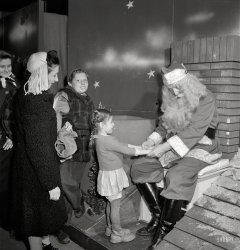
- Day Trippers: 1906
- ... station at Petoskey, Michigan." A locomotive of the Grand Rapids & Indiana Railroad, with a car bearing the names of Little Traverse ... Posted by Dave - 04/20/2016 - 12:16pm -
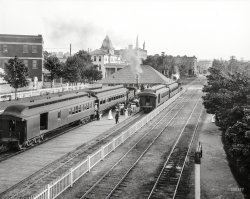
- The Greatest Thing: 1939
- ... Oliver Machinery Co. Still in business, it started in Grand Rapids building high quality woodworking tools. After about 100 years of ... Posted by Dave - 06/03/2018 - 6:47pm -
![The Greatest Thing: 1939 November 1939. "Slicing bread at bakery. San Angelo, Texas." Medium format negative by Russell Lee for the Farm Security Administration. View full size.
Long lasting techThat slicer uses the same type of slicing blades as the new machine in my local bakery. The new one has added safety features, of course. I guess it was a great thing!
Not Done YetThis bread slicer looks exactly the same as the one at our local supermarket, Dorothy Lane.
It is a specialty store with the best homemade bread and the bread slicer looks just like this one.
Ok, just can't resist this!
I wonder how much DOUGH this guy makes at his job? Hope he isn't too CRUSTY after a hard day's work. Well at least this photo is a look at a SLICE of pre WWII life.
No loafing, but no gloves hereYep, he's putting his bare hands onto each sliced loaf. And he has enough grease in his hair to lubricate the machine if it starts to seize up.
Been Around a WhileOliver is the same brand of slicing machine I see used in Panera today.
Greatest Title Too!I literally laughed out loud. Well done.
[Please, no applause. Just throw money! - Dave]
Greatest Thing?... since Betty White, maybe.
Cutting UpThe greatest thing? "Preslicely" what I was thinking!
Rock SlicerI KNEW I'd seen one of those machines before.
Here's an Oliver bread slicer being operated by an Alcatraz convict in the penitentiary kitchen circa 1945.
What A Historic FigureBut I thought Oliver Crumbwell was a person.
Anyways, I was just thinking about this the past week. Hearing the saying so much, I was thinking about how did they go about slicing it and exactly how excited people were to get bread you didn't have to slice yourself anymore, this photo cures my curiosity and confirms my suspicion.
"Oliver"So called because it's more grueling.
Oliver Machinery Co.Still in business, it started in Grand Rapids building high quality woodworking tools. After about 100 years of ownership by the Oliver family, it was sold.
(The Gallery, Russell Lee)](https://www.shorpy.com/files/images/SHORPY-8b23569a.thumbnail.jpg)
- The Club: 1900
- ... at all those chairs! Do you think they came from the Grand Rapids Chair Company?
Horns I wonder who put those horns up on the ... Posted by Dave - 08/02/2012 - 4:14pm -
![The Club: 1900 Huron County, Michigan, circa 1900. "Dining room at the Club, Pointe aux Barques." 8x10 inch glass negative, Detroit Publishing Company. View full size.
Health and SafetyDon't you love that wiring? Health and Safety would have a field day with wires strung across a wooden ceiling and tapped into for every light.
Elegant DiningWould really like to have a meal here. Imagine of the ambiance.
Into the WoodsWood floors, wood beams, wood ceilings, wood walls, wood doors, even wood tables and wood chairs. Does anyone want to lay odds on how long before the whole place burns to ashes?
Rustic to a FaultThe bare light bulbs hanging down from the ceiling along with the split beams and supports. Only thing missing is peanut shells on the floor.
Look at all those chairs!Do you think they came from the Grand Rapids Chair Company?
HornsI wonder who put those horns up on the rafters top left. There is nothing else attached to the rafters anywhere. Just the solitary horns.
[That's a metal bracket. With a string attached. - Dave]
GorgeousI'll bet all that knotty pine and/or cedar positively glowed when the window shades were up. That wiring was safe enough when it was brand new, given a few years of wear and tear, somewhat less so.
(The Gallery, DPC, Eateries & Bars)](https://www.shorpy.com/files/images/SHORPY_4a07910a.thumbnail.jpg)
- At the Y: c.1900
- "Grand Rapids YWCA" is written in pencil on the back of this print from Michigan. There is no date, but the Grand Rapids YWCA was opened in 1900. To my eye the outfits do not look much ... Posted by JeffK - 04/13/2018 - 9:07pm -
